ISSN ONLINE(2319-8753)PRINT(2347-6710)
ISSN ONLINE(2319-8753)PRINT(2347-6710)
Kuldip A Rade1, V.A. Pharande 2, D.R. Saini3
|
| Related article at Pubmed, Scholar Google |
Visit for more related articles at International Journal of Innovative Research in Science, Engineering and Technology
A detailed study was conducted for small the scale textile industry in depth for the various processes involved, chemicals required, raw material and equipment details, operating parameters, energy requirements during processes including different losses etc. and to optimize thermal energy requirements in order to achieve acceptable good quality of cotton coloured products. In Indian dye (textile) industry, the major factors affecting regarding energy consumption. In addition, some technical information’s has been included with schematics processes used for production as also machineries.
Keywords |
| Textile, Dyeing, Thermal Energy, Optimization, Materials, Processes. |
INTRODUCTION |
Current position of small scale textile industry in India: |
| India earns about 27% of its total foreign exchange through textile exports and contributes nearly 14% of the total industrial production of the country. Indian textile industry is the largest in the country in terms of employment generation; currently it generates employment more than 35 million people. It is also estimated that the industry will generate 12 million new jobs by the year 2014. |
World’s total textile demand and production base distribution: |
| World population will grow from the present 5.4 billion to 10 billion in 2050, and further to 11.6 billion in 2150 when it is expected to reach a steady state. The total textile consumption forecast is going to double, even using the current figure of per capita annual average textile consumption (8kg/person).[2] |
Processes used in Small Scale Textile Industries: |
| Figure 1 revels the flowchart for textile processing. |
| Raw material Supply: Natural fibers may be organic or inorganic in nature. Man-made fibers are broadly classified as organic regenerated natural fibers |
| Yarn preparation: The preparation for spinning of raw material components into consistent and continuous fiber filaments (i.e. thread or yarn). The production of continuous fiber is hand or machine processed |
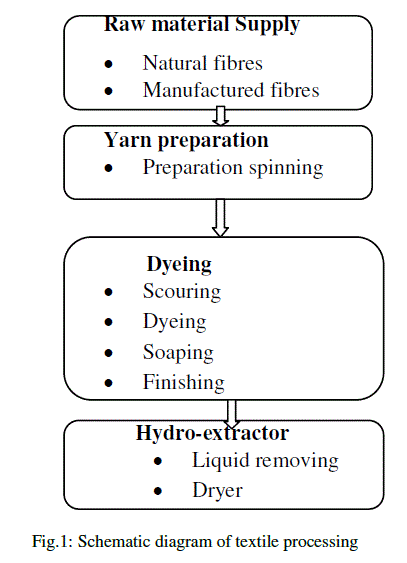 |
| Figure 2 shows the flow chart for dyeing process. |
| Scouring is the process of removal of natural oil substances like waxes, fats and pectin’s as well as added impurities like lubricating oil, dust, dirt and residual starch in cotton materials. Scouring means holding mixture of water and scouring agent like saracol at high temp. Scouring is done at 90-110⁰C. |
| Dyeing is a process of driving the cheese with dyes at 60⁰C for one hour. Temperature and time of dyeing process is depends on type of shade whether it is dark or light. |
| Soaping is post process in dyeing.Soaping is the process of removal of extra dyestuff which is coagulated on cheese. Soaping is done at 80-90⁰C in presence of soaping agents. |
| Finishing is a last process in dyeing. It includes two hot washes but for dark shade more than two hot washes are given till bath is not clear. After finishing, yarn is passed through hydro extracting machine for further processing.[4][6] There are different analysis techniques of optimization such as |
| 1. Fuzzy decision system a) similarity analysis b) Decision analysis |
| 2. Cluster analysis. |
| 3. Soft computing techniques |
| 4 Generic Algorithm 5. Fuzzy logic control |
| 5. Fuzzy logic control |
| 6. Pinch analysis |
| 7. Stochastic mechanics approaches |
| Pinch technology is simple methodology of systematically analyzing chemical processes and the surrounding utility systems with the help of first and second law of thermodynamics. The first law provides the energy equation for calculating enthalpy changes (H) and the second law determines the direction of heat flow that is heat energy may only flow in the direction of hot to cold. |
| The objective of pinch analysis is to achieve energy savings by better process heat integration (maximizing process to process heat recovery and reducing external utility loads). It is applied to solve a wide range of problems in main stream chemical engineering. Wherever heating and cooling of process materials takes place, there is a potential opportunity. This technology is used in projects relating to energy saving in industries such as iron and steel , food and drink , textiles ,paper and cardboards , cements , base chemicals, oil and petrochemicals. |
Bench Scale Experimental Results: |
| The optimization of variable parameters in dyeing process were conducted on bench scale unit as shown in Fig.3 and the block diagram for the same is depicted in Fig.4. The variable identified for the energy optimizations were temperature of dyeing process, time for dyeing process and consistency in the dyeing (water quantity, chemicals used for processing, quality and concentration of the dye etc.). The observations and results presented in Table No. 1 to ----. |
 |
LITERATURE REVIEW |
| Dr. Nasir Mukhtar Gatawa and Prof. C. U. Aliyu (2013) [1] Presented that electricity consumption has significant positive influence on textile output. Stable and reliable power supply is necessary to generate optimum production at lower cost so as to enhance utilization of idle resources, expand factor incomes, improve competitiveness and expand overall textile output |
| Prof. Tanaji Dabade and Dr. Shivaji Gawade (2012) [2] presented that the textile industry holds significant status in the India and it accounts for 14% of the total industrial production. It contributes to nearly 30% of the total exports and it is the second largest employment generator after agriculture. |
| Khalil Elahee (2011) [3] Described the techniques and technologies of heat recovery from waste water and exhaust air are analyzed. Experiences prove that in most cases heat recovery requires low investment and has a low payback of normally less than 2 years. The case of the Mauritian dyeing and finishing industry is highlighted, including the possible use of a low-cost heat recovery unit made from indigenous resources. |
| Ali Hasanbeigi (2010) [4] presented information on energy-efficiency technologies and measures applicable to the textile industry. The guidebook includes case studies from textile plants around the world and includes energy savings and cost information when available. An analysis of the type and the share of energy used in different textile processes has carried out. Subsequently, energy-efficiency improvement opportunities available within some of the major textile sub-sectors are given with a brief explanation of each measure. The conclusion includes a short section dedicated to highlighting a few emerging technologies in the textile industry as well as the potential for the use of renewable energy in the textile industry. |
| Mr. S. Ashok (2010) [5] presented that electricity consumption is increasing in Textile mills, due to prolonged use of the equipments in inefficient operating parameters. So focus area now is Energy consumption @ load end and by optimizing the energy usage of textile machines, we can have multiple benefits of less units per kg of yarn and health of machines enhance. |
| Ahmet Cay (2009) [6] described the study of the energetic assessment of exhaustion processes for textile fabrics using actual operational data. The process temperature and time, water inlet temperature and liquor ratio were found to be the main parameters that affect energy destruction rates. The effects of carry-over on energy destruction rates were also investigated. It was shown that, 23% and 50% of total energy destruction rate were occurred by the bleaching and the washing steps for cotton finishing, respectively, while 32% of total was accounted for the dyeing step of polyester finishing. High temperature processes had higher energy efficiency values. |
| Nahed S. E. Ahmed (2009) [7] described that the textile coloration is a wet process that uses dyes, chemicals, and large volume of water. The driving force being the need for cleaner, cost-effective, and value-added textile products. This review will provide a summary of recent developments in the coloration of textile fiber. Emphasis will be paid to the new technologies, in particular those based on physicochemical means such as nanotechnology, electrochemistry, supercritical carbon dioxide coloration, plasma, ultrasonic and microwave, and their uses in the coloration of textile fibers. |
| Rajakumari et al., 2008 [8] have invented and studied inputs for treating textile waste water using pretreatment, reverse osmosis and evaporator for to representative textile waste water treatment plants. Study reveals that evaporator consumes 48% of electricity, which contribute for more global warming potential than other treatment unit. |
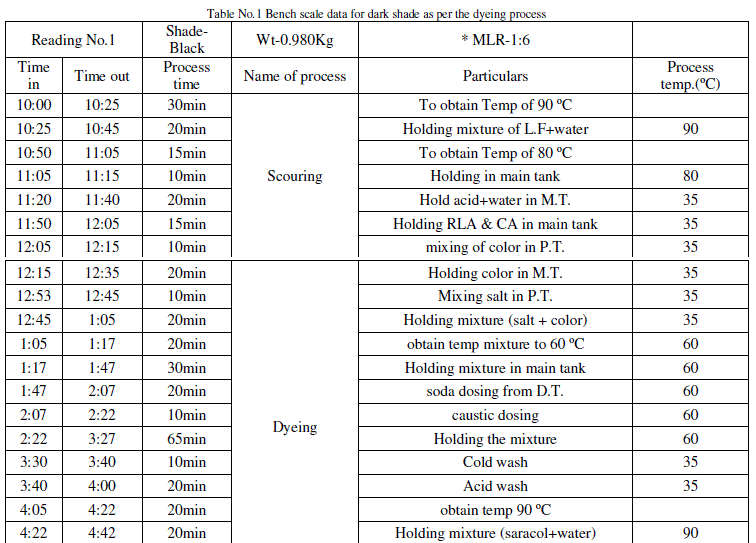 |
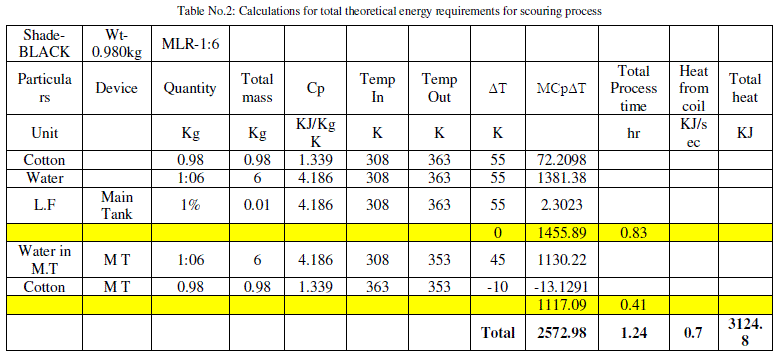 |
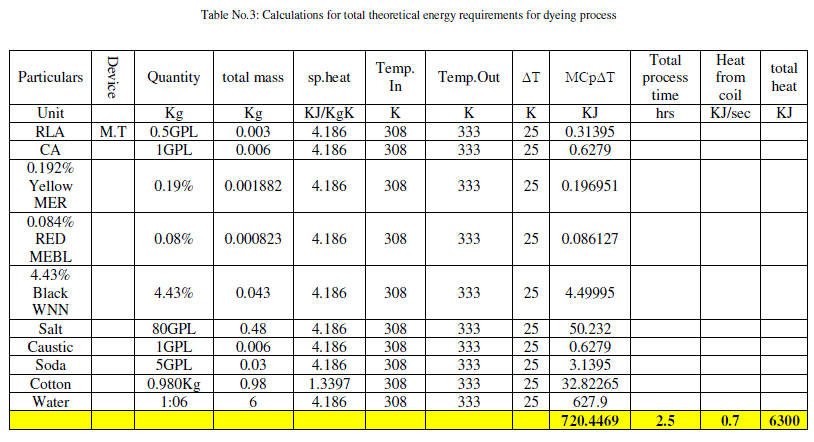 |
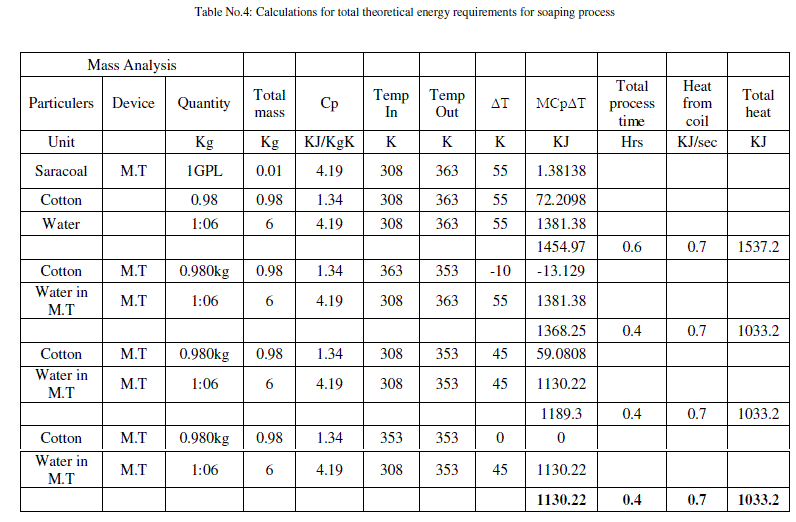 |
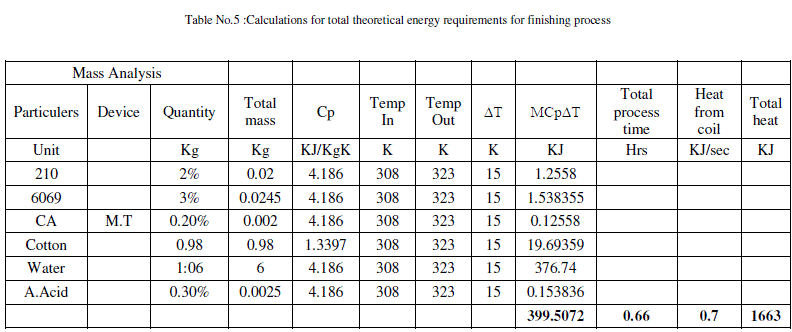 |
RESULT |
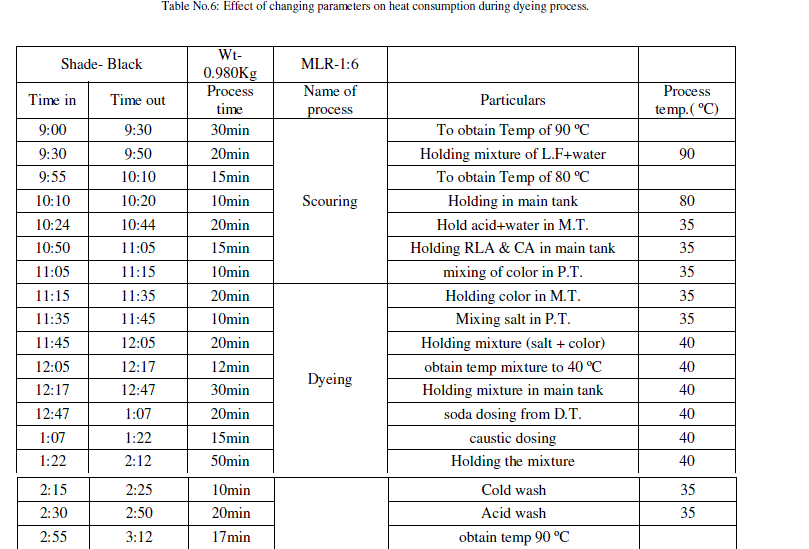 |
| Based on large number experiments conducted on bench scale unit, thermal analysis for optimized operating parameters for various operations are carried out through thermal equation Q=M.Cp.(T2-T1) where, Q heat supplied Cp specific heat T2-T1 process temperature difference. |
| As per results obtained from calculation graph is plotted of percentage heat loss Vs temperature at various time as shown in Fig. Optimum point was determined at 60⁰ C and 50 min of dyeing process. The percentage heat loss at that point is 36.57%. |
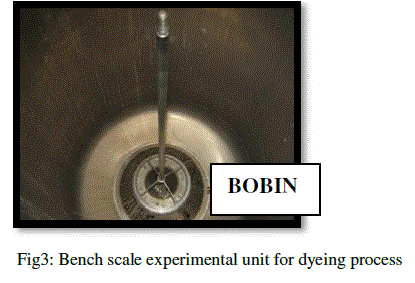 |
Quality confirmation at optimized parameters for dyeing process: |
| Color fastness is the resistance of a material to change any of its color characteristics or extent of transfer of its colorants to adjacent white material in touch the color fastness is usually rated either by loss of depth of color in original sample or it is also expressed by staining scale i.e. the accompanying white material gets tinted or stained by color of original fabric. However, among all types of color fastness, light fastness, wash fastness and rub fastness are considered generally for any textiles; perspiration fastness is considered specifically for apparels only. |
| Light fastness of many natural dyes, particularly which are extracted from flower petals are found to be poor to medium. So an extensive work has been carried out to improve the light fastness properties of different natural dyed textile. Most of the natural dyes have poor light stability as compared to the best available synthetic dyes and hence the colors in museum textile are often different from their original color. |
| Duff studied the light fastness and wash fastness under the standard condition (50ºC) and also at 20ºC with washing formulation used in conservation work for restoring of old textiles. Some dyes undergo marked changes in hue on washing due to presence of even small amount of alkali in washing mixture, highlighting the necessity to know the pH of alkaline solution used for the cleaning of textile dyed with natural dyes. As a general rule, natural dyes show moderate wash fastness on wool, as assessed by the ISO II test. |
| In general, rub fastness of most of natural dyes is found to be moderate to good and does not require after treatment. However, it must be remembered that the color fastness of natural dyes not only depends upon chemical nature and type of natural colorants, but also on chemical nature and type of mordant’s being used. So a dyer must know the use of proper combination of fiber-mordant to achieve best color fastness. |
| Keeping the dyeing quality in view, particularly rubbing and washing and the results obtained are presented in the Table No.8. |
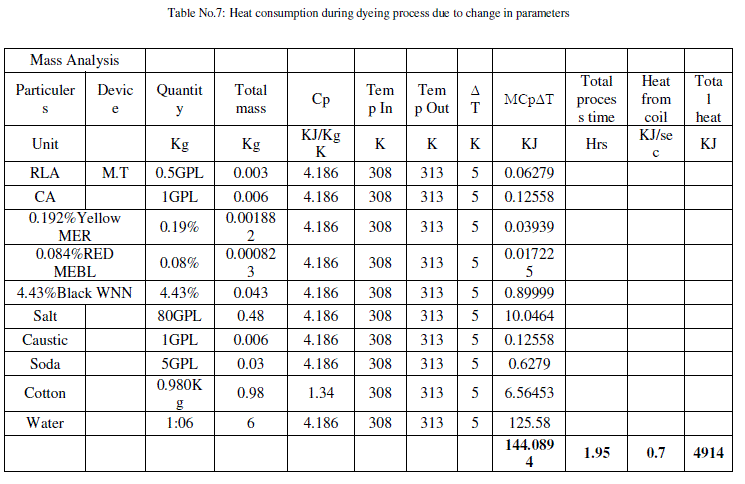 |
| *Yes - indicates transfer of its colorants to adjacent white material |
| **No- indicates there is no transfer of colorants to adjacent white material |
CONCLUSION |
| The objective was to optimize the process parameters and experiments were conducted by varying different parameters such as temperature, time, etc. A mathematical calculations have been carried out for heat consumption. It is found that process parameters have the significant influence on the heat consumption. |
| Heat consumption increases temperature for the same consistency in the dyeing process with respect to time. The optimized values of parameters are found out for minimum heat loss. The heat consumption for the process with exiting practices that are followed in the small scale industries is of the order of 6900 KJ and the heat consumption after optimization reduces to around 5100 KJ and percentage thermal energy saving is to the tune of 24%. This study has wider applications for all small scale dyeing units in India. The process reliability of the system can be enhanced by integrating or combining all the process parameters, resulting in the cost per unit power consumption using reliability model. Use of reliability model will result in lower consumption of raw materials, water, dyes and energy, enabling the dyeing units in lowering the environmental pollution. |
ACKNOWLEDGEMENT |
| Authors are grateful to M/s Cotspin Textiles Pvt. Ltd., Thane, M/s Shree Chintamani Silk Mills Pvt. Ltd., Theur, Pune, Prerna Yarn Dyeing Industry, Islampur, Sangli for giving necessary permission and also equipment along with chemicals for conducting the optimization studies at their premises. Authors also thank Dr. S. N. kaul, Fmr. Actg. Director, NEERI, Nagpur for his technical inputs. |
References |
|